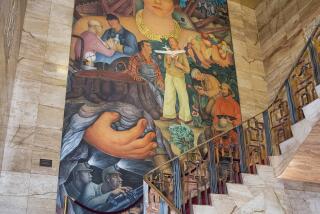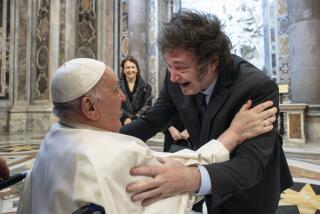Father Junipero Serra: California hero or villain?
Pope Francis’ announcement that he plans to canonize Father Junipero Serra has generated both cheers and anger across California. Here’s a primer on one of California’s dominant historical figures.
Q: Who is Serra?
Father Serra was the 18th-century Spanish Franciscan priest who founded nine missions in California and spread Catholicism around the western United States.
Serra was born on the Spanish island of Mallorca on Nov. 24, 1713, and volunteered for New World mission work at age 36 after obtaining a doctorate in theology and developing a career in religious academia in Spain, according to a biography on the Santa Barbara Province of the Franciscans’ website.
He was first assigned to the remote Sierra Gorda region in what is now south-central Mexico’s Queretaro state. He worked among indigenous Pame Indians, then embarked on an itinerant preaching mission across Mexico.
In 1758, he was dispatched to head a group of other Spanish Franciscans in evangelizing the inhabitants of Baja and Alta California, as the current U.S. state was then known.
He settled 11 years later in San Diego, where he spent most of his remaining years.
Q: Why is he so controversial?
The mission system cemented Catholicism in the state but nearly eradicated several Native American tribes.
Before Serra’s arrival, hundreds of thousands of indigenous people had lived in what is today California.
But the mission system imposed pressure on American Indians to assimilate while also exposing thousands to foreign diseases, wiping out villages, native animals and plants.
Q: How have school teachings of the mission era changed over the years?
The Times wrote in 1997 about how school lessons were taking a harsher tone about Serra:
The history lesson was well known to generations of California schoolchildren: Father Junipero Serra and his Franciscan disciples converted Indians from heathen savages into God-fearing Christians, filling their bellies with meat, their souls with enlightenment.
“The Indians had the feeling of being part of something much bigger than the old Indian village,” wrote the authors of a standard 1965 textbook. “On the whole, they must have felt better off than before.”
The lesson of the 1990s is starkly different: Although Serra and his Spanish brethren came with lofty intentions, their arrival in 1769 signaled the demise of the very people they sought to save.
“For the people who had lived in California for hundreds of years before the Spanish arrived, the growth of the missions was tragic,” says the state-adopted textbook currently read by fourth-graders, for whom state history is mandatory. “Thousands of Indians died, and by the end of the 1800s much of the Indian way of life had died also.”
Q: Has the church addressed the issue in the past?
A: In 1987, Pope John Paul II acknowledged that the church had committed “mistakes and wrongs” against American Indians but defended the record of Serra.
Q: What has been the reaction in the local Catholic Church?
Archbishop Jose Gomez, head of the archdiocese of Los Angeles, called Serra one of his “spiritual heroes.”
“It’s wonderful to think that this new saint once walked the road that is now the Hollywood Freeway and called it El Camino Real, ‘The King’s Highway,’ ” Gomez said in a statement, noting that two of Serra’s missions are located within the archdiocese’s territory: missions San Gabriel Arcangel and San Buenaventura.
More to Read
Start your day right
Sign up for Essential California for news, features and recommendations from the L.A. Times and beyond in your inbox six days a week.
You may occasionally receive promotional content from the Los Angeles Times.






